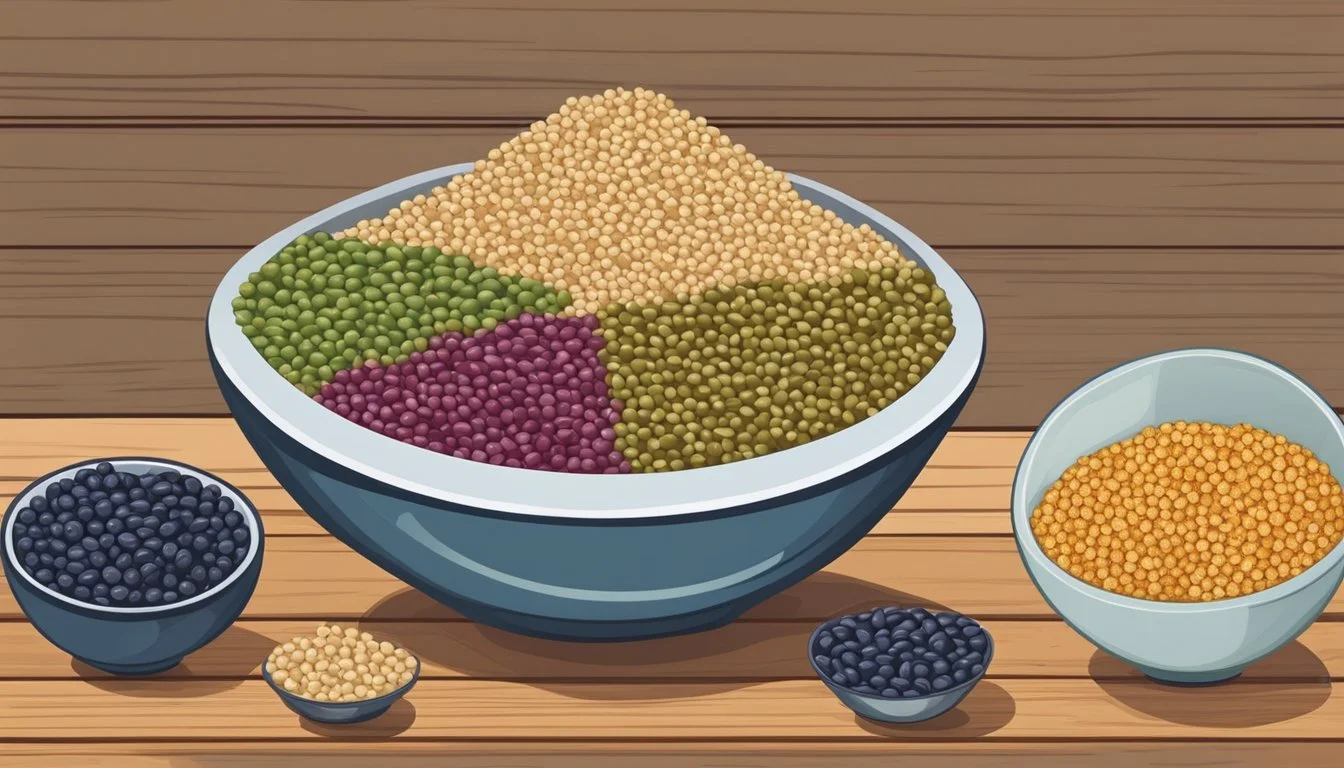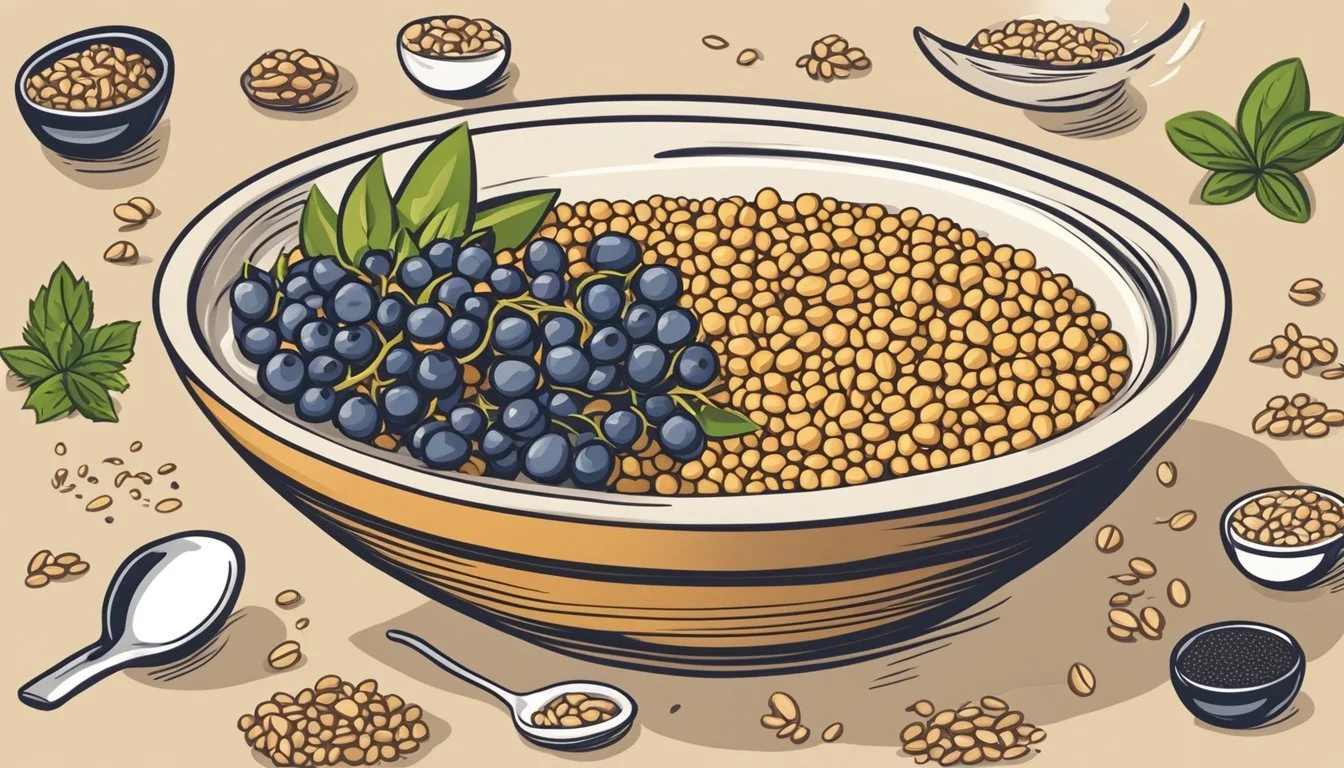Kamut Berries Substitutes
Best Alternatives for Cooking
Kamut berries, known for their rich, nutty flavor and impressive nutritional profile, have been cherished for centuries as a staple ancient grain. However, there are times when Kamut berries are not available or suitable for certain dietary needs. Emmer flour, also known as farro, is an excellent substitute, offering a similar taste and nutritional benefits such as high fiber and protein content.
For those seeking gluten-free options, buckwheat is a fantastic alternative. Buckwheat provides a comparable earthy taste and is packed with fiber, protein, and essential minerals like magnesium and manganese. This makes it a great choice for individuals with gluten sensitivities.
Another viable option is barley, which can seamlessly replace Kamut berries in various dishes. With a slightly lower gluten content, barley works well in soups, stews, and salads, offering versatility and a hearty texture. Incorporating these substitutes ensures that your meals remain nutritious and flavorful, even when Kamut berries are not on hand.
Understanding Kamut Berries
Kamut berries, known for their rich, nutty flavor and chewy texture, are an ancient grain with a distinguished history and notable nutritional benefits. Their unique qualities make them a versatile ingredient in a variety of culinary applications.
Origin and History of Kamut
Kamut, also known as Khorasan wheat, traces its roots back to ancient Egypt and Mesopotamia. This grain was rediscovered in the 20th century and marketed under the trademark Kamut. The name "Kamut" is derived from the ancient Egyptian word for wheat.
This grain is celebrated for its resilience and ability to thrive in harsh conditions. Kamut gained popularity in the modern era due to its distinct characteristics and health benefits, making it a preferred choice among health-conscious consumers.
Nutritional Profile of Kamut
Kamut is revered for its impressive nutritional profile. A serving typically provides higher protein content compared to modern wheat, with around 6 grams of protein per 1/4 cup. It is also rich in fiber, aiding in digestion and promoting satiety.
Vitamins and minerals found in Kamut include magnesium, zinc, iron, and selenium, essential for various bodily functions. The grain's robust nutritional makeup supports a balanced diet, offering a wholesome alternative to contemporary wheat varieties. These attributes contribute to Kamut's reputation as a nutrient-dense whole grain.
Culinary Uses and Attributes
In the kitchen, Kamut berries shine due to their nutty flavor and chewy texture. These qualities make them suitable for both savory and sweet dishes. Kamut can be used in salads, soups, stews, and even as a rice substitute.
When baking, Kamut flour imparts a distinctive taste and hearty texture to bread and pastries. Its high protein content also benefits baking, providing better dough elasticity and structure. Cooking Kamut is straightforward, often involving soaking before boiling to achieve the desired tenderness.
From versatile usage in cooking and baking to its nutritious benefits, Kamut offers a unique and healthy addition to various culinary creations.
Health Considerations
When selecting substitutes for Kamut berries, it's essential to consider various health factors such as gluten content, potential benefits for chronic diseases, and compatibility with different dietary preferences.
Gluten Content and Sensitivities
Kamut contains gluten, making it unsuitable for individuals with celiac disease or gluten intolerance. People sensitive to gluten should consider alternatives such as buckwheat, which is gluten-free yet offers a similar nutty flavor. Emmer flour, while nutritious and flavorful, also contains gluten and should be avoided by those with gluten sensitivities.
Substitute Gluten-Free Notes Buckwheat Yes Good for gluten sensitivity Emmer Flour No Contains similar nutrients
Benefits for Chronic Diseases
Substitutes for Kamut berries, like buckwheat and emmer flour, provide notable nutritional benefits. Both are rich in fiber, aiding digestive health and may help lower cholesterol levels. These grains contribute to heart health and can be beneficial for managing chronic diseases such as diabetes due to their low glycemic index.
Buckwheat in particular is high in antioxidants, which protect against cellular damage. Emmer flour is packed with essential minerals like iron and magnesium, supporting overall well-being.
Dietary Preference Compatibility
When choosing a Kamut substitute, dietary preferences such as veganism and vegetarianism should be considered. Buckwheat fits well within vegan and vegetarian diets, offering a good source of plant-based protein. Emmer flour is also suitable, providing significant protein and other vital nutrients that support a plant-based lifestyle.
For those focused on nutritional benefits, buckwheat can be an excellent addition due to its high fiber and protein content. Emmer flour's unique flavor profile and nutritional richness make it a versatile choice for various recipes.
Kamut Substitutes
When looking for substitutes for Kamut, it's important to consider grains and flours that mirror Kamut’s nutty flavor, nutritional content, and, where necessary, gluten-free properties. This guide covers various options for replacing Kamut in recipes and their potential benefits.
Similar Ancient Grains
Spelt: Spelt is a versatile ancient grain closely related to modern wheat. It has a slightly sweet and nutty flavor, similar to Kamut. It's rich in protein, fiber, and essential minerals. It can be used in place of Kamut in many recipes, including breads and pastas.
Farro: Also known as Emmer, farro has been cultivated for thousands of years. It offers a nutty and slightly sweet taste, comparable to Kamut. Farro is rich in fiber, protein, iron, and magnesium. It works well in soups, salads, and risottos.
Einkorn: Einkorn is one of the earliest cultivated forms of wheat. It has a mild flavor and can substitute Kamut in a variety of dishes. With its high protein and mineral content, Einkorn is a nutritious alternative.
Gluten-Free Alternatives
Buckwheat: Despite its name, buckwheat is gluten-free. It has a robust, nutty flavor similar to Kamut. Buckwheat is rich in fiber, protein, and essential minerals like magnesium and manganese. It's ideal for those with gluten sensitivities.
Quinoa: Quinoa is a popular gluten-free option known for its high protein content and balanced amino acid profile. Its subtle nutty taste makes it a suitable Kamut replacement in salads, pilafs, and breakfast dishes.
Amaranth: Amaranth is another nutrient-dense, gluten-free grain. It has a slightly earthy flavor and can be used in various recipes, from porridges to baked goods. Amaranth is rich in protein, fiber, and micronutrients.
Common Wheat Substitutes
Barley: Barley has a similar texture to Kamut when cooked and a mild, slightly sweet flavor. It’s high in fiber and can be used in stews, soups, and salads. However, it contains gluten, so it’s not suitable for a gluten-free diet.
Freekeh: Freekeh is made from green durum wheat and has a chewy texture and a smoky, nutty flavor. It is high in protein and fiber, making it a healthy Kamut substitute. It's perfect for savory dishes like pilafs and salads.
Teff: Teff is a tiny grain that packs a nutritional punch. It has a mild, nutty flavor and can be used as a Kamut substitute, especially in baking. Teff is rich in protein, iron, and calcium. It is versatile for making bread or porridge.
Creative Substitutions in Recipes
Millet: Millet’s mild flavor makes it a versatile choice in various recipes. Use it in place of Kamut for dishes that require a fluffy texture, such as pilafs or as a rice alternative. Millet is gluten-free and high in fiber and antioxidants.
Rice: Both brown and wild rice can substitute Kamut, especially in pilafs and casseroles. Rice has a neutral flavor that can absorb seasonings well. Brown rice provides more fiber and nutrients than white rice, making it a healthier choice.
Quinoa: Quinoa’s versatility allows it to replace Kamut in both sweet and savory dishes. Its quick cooking time and high nutritional value, including complete proteins, make it suitable for salads, stews, and even baking.
Each of these substitutes offers unique benefits and can be tailored to specific dietary needs and recipe requirements, ensuring that meals remain both healthy and flavorful.
Choosing Substitutes Based on Nutritional Goals
Selecting a suitable substitute for Kamut berries hinges on the specific nutritional properties you are aiming to include in your diet. Whether it's higher protein, more fiber, or essential minerals, each substitute offers unique benefits.
Comparing Nutritional Profiles
When looking at nutritional profiles, it's essential to compare key nutrients. Buckwheat stands out for its nutty flavor and is gluten-free. It’s an excellent source of fiber, magnesium, and manganese.
Quinoa is another versatile option, providing complete proteins and all nine essential amino acids. It is rich in B vitamins, iron, and calcium.
Amaranth offers a higher protein content relative to other grains and also packs a good amount of fiber and iron. These alternatives are particularly beneficial for those with gluten sensitivity.
Substitutes Rich in Specific Nutrients
For fiber, buckwheat and quinoa are excellent options. Buckwheat provides dietary benefits which support digestion. Quinoa's fiber content helps with satiety and maintaining a healthy gut.
In terms of protein, amaranth and quinoa are top choices. Amaranth has a high protein profile, beneficial for muscle repair and growth. Quinoa, a complete protein, supports overall muscle and tissue health.
For essential minerals, magnesium, zinc and iron are crucial. Buckwheat and quinoa offer substantial magnesium which is critical for nerve and muscle function. Amaranth provides a notable amount of iron and calcium, essential for blood health and bone strength.
Including these substitutes based on your nutritional goals ensures a balanced and health-conscious diet.
Practical Tips for Substitution
Using substitutes for Kamut berries requires attention to cooking techniques, texture, and flavor. When baking, it's essential to know how different grains affect the final product, such as breads and cakes.
Adjusting Cooking Techniques
When substituting Kamut berries in recipes, it's crucial to adjust cooking times and water ratios. Buckwheat cooks faster, so reduce the cooking time. For instance, instead of 45-60 minutes for Kamut, try 15-20 for buckwheat.
Farro and barley need similar cook times but may require more liquid. Use a 1:3 grain-to-water ratio. This is vital for dishes like pilafs or casseroles to achieve the right consistency.
Kamut's nutty flavor and chewy texture can be matched by toasting millet before cooking to enhance its flavor in side dishes or salads.
Texture and Flavor Considerations
Kamut's nutty and earthy taste, along with its chewy texture, is unique. Emmer flour offers a similar flavor profile, making it a suitable option for pastas and side dishes. It can be slightly sweeter, which might enhance cookies and cakes.
Quinoa can be a good match texture-wise but has a milder flavor. If using quinoa in salads or pilafs, consider additional seasoning to replicate the nutty essence of Kamut.
For those requiring a gluten-free substitute, buckwheat delivers a comparable chewy texture and earthy taste, especially effective in casseroles and pastas.
Substitutions in Baking
When replacing Kamut in baking, choices like whole-wheat flour or spelt flour can maintain the grain's integrity in breads and cakes. Spelt flour, being close in protein structure, aids in maintaining the loaf's shape and rise.
Almond meal can substitute Kamut in cookies and cakes, offering a nutty flavor. Remember to adjust liquid ingredients due to its higher fat content.
For an entirely gluten-free option, buckwheat flour can provide density and flavor but might require additional binding agents like xanthan gum to achieve the desired texture.
Substitute Recommendations by Dish Type
Choosing the right substitute for kamut berries depends on the type of dish you are preparing. Here are some recommendations tailored to breads and pastries, salads and side dishes, and main courses and casseroles, focusing on the best alternatives to maintain flavor, texture, and nutritional benefits.
Breads and Pastries
For breads and pastries, it's crucial to select substitutes that maintain the structure and rise typically provided by kamut. Spelt flour and emmer flour are excellent choices because of their similar protein content and nutty flavor. Spelt flour can be used in a 1:1 ratio, making it an easy switch for recipes. Einkorn flour is another good option but may require slight adjustments in hydration due to its ancient grain qualities.
Spelt Flour: High in protein, similar texture.
Emmer Flour: Provides a nutty flavor, good for traditional recipes.
Einkorn Flour: May need more liquid, offers rich taste.
Salads and Side Dishes
Salads and side dishes benefit from grains that retain a toothsome texture similar to kamut berries. Buckwheat and farro (emmer) are top substitutes. These grains offer a pleasant chewiness and nutty flavor that complements a variety of ingredients. Quinoa is also a versatile substitute, appropriate for cold grain salads, providing a slightly different but appealing texture and taste.
Buckwheat: Gluten-free, nutty, chewy.
Farro (Emmer): Nutty flavor, hearty texture.
Quinoa: Light, slightly crunchy, protein-rich.
Main Courses and Casseroles
For main courses and casseroles, choose grains that can absorb flavors well and hold their shape during cooking. Barley and brown rice are ideal for hearty dishes. Barley has a chewy texture that stands up well in soups and stews. Brown rice offers a neutral flavor that can take on the spices and ingredients in casseroles, ensuring a balanced dish without overpowering other components.
Barley: Chewy, holds shape, absorbs flavors.
Brown Rice: Neutral, robust enough for casseroles.
Farro (Emmer): Versatile, fits well in various recipes.
These substitutes provide various options based on specific needs, ensuring each dish retains its desired taste and texture.
Adapting Kitchen Pantry for Substitutes
Kamut berries are an ancient wheat known for their nutty flavor and nutritional benefits. When substitutes are needed, consider stocking your pantry with other ancient grains and whole grains.
Substitution List
Farro: Another ancient grain, farro offers a similar nutty taste and texture. It's rich in fiber and protein, making it an excellent Kamut substitute.
Emmer flour: Known as farro flour, emmer is an ancient grain that mirrors Kamut's slightly sweet and nutty flavor. Usage: Suitable for baking and cooking.
Buckwheat: Gluten-free and nutritious, buckwheat has a nutty and earthy taste. It's high in fiber, protein, magnesium, and manganese. Ideal For: Gluten-sensitive individuals.
Storage Tips
Airtight Containers: Store grains in airtight containers to keep them fresh longer.
Cool, Dry Place: Keep your pantry dry and cool to avoid spoilage of grains.
Nutritional Benefits
Grain Protein Fiber Key Minerals Kamut High High Magnesium, Zinc, Iron Farro Moderate High Magnesium, Zinc, Iron Buckwheat High High Magnesium, Manganese
Cooking Tips
Soaking: Soak grains like Farro and Emmer before cooking to reduce cooking time and enhance texture.
Simmering: Cook grains in a 2:1 water to grain ratio until tender, approximately 30-40 minutes.
These substitutions and tips help maintain the nutritional and flavor profile of your dishes when Kamut berries aren't available.







